Interview with David H. Ahl, founder of the Creative Computing magazine
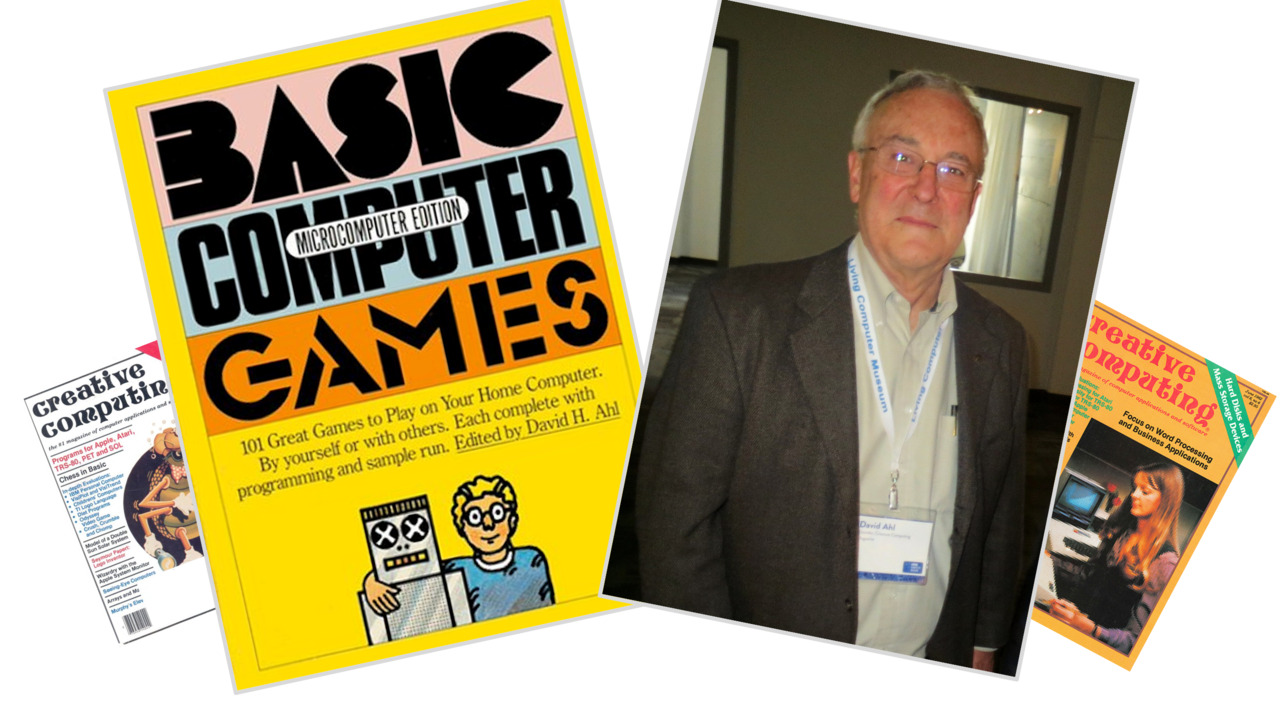
A few weeks ago, I had the chance to meet, online, Mr. David H. Ahl, the legendary founder of the Creative Computing magazine. It was unexpected, and I was so happy to start exchanging messages with him. David Ahl is a real visionary. He created Creative Computing, the first magazine dedicated to home computers, in 1974, even before home computers existed! David Ahl is also the author of several books, including BASIC COMPUTER GAMES, the first programming book to sell more than one mln copies. Mr. Ahl agreed to do a virtual interview that I'm publishing here. Enjoy!
Mr. Ahl, it's a great honor to have met you electronically, and I'm so happy you have accepted to do this virtual interview. In Europe, we were not so lucky to have Creative Computing, but I'm sure your work has influenced the books and magazines that I was reading in the 80s. If I became a programmer, it's also thanks to you.
1. Do you remember when you started being interested in computers and programming? What was it like working on mainframes before personal computers were invented?
The first computer I used was a Burroughs B200 at Cornell University in 1959. At the time, it was the ONLY computer for student use on campus, and it was located in the School of Mechanical Engineering. It was programmed in machine language or Algol using punch cards.
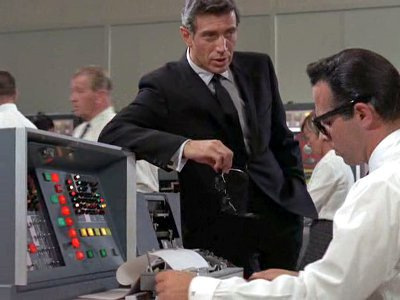
The operating system was primitive by today's standards and your program had to keep track of all kinds of things that we now take for granted like how much mag tape was let of the reel, what to do if a stack overflowed, a count of the number of characters printed on a line of output so you could throw in a carriage return to move the teletype printer to the next line. You spent as much time on these "trivial" details as the actual program computations and logic. Programming back then was quite tedious and almost boring.
2. What was your first personal computer?
Ha, ha. My first personal computer was a MITS Altair 8800 kit in mid-1975. I still have the S-100 bus Altair 8080 CPU board and Altair 4K memory board with 28 DIP ICs; each pin had to be soldered individually onto the board.

The main software package on the computer was Michael Shrayer's Electric Pencil word processing software (released Dec 1976), and it was as good in every way as Wang's dedicated word processor.
3. What was your favorite computer in the 80s? Commodore 64, Atari 800, Apple II, IBM PC, Amiga, or something else?
Preferences changed over the years. Of the S-100 bus machines, the Processor Technology Sol-20 was my favorite, very user-friendly in both ergonomics and software. The designer, Lee Felsenstein, really did a great job with this one. The Apple II had its place in music and graphics and, of course, Visi-Calc, the first spreadsheet. But I actually liked the TRS-80 Model III because it was self-contained with dual floppy discs, and it too ran Electric Pencil, so I didn't have to learn a new word processor.
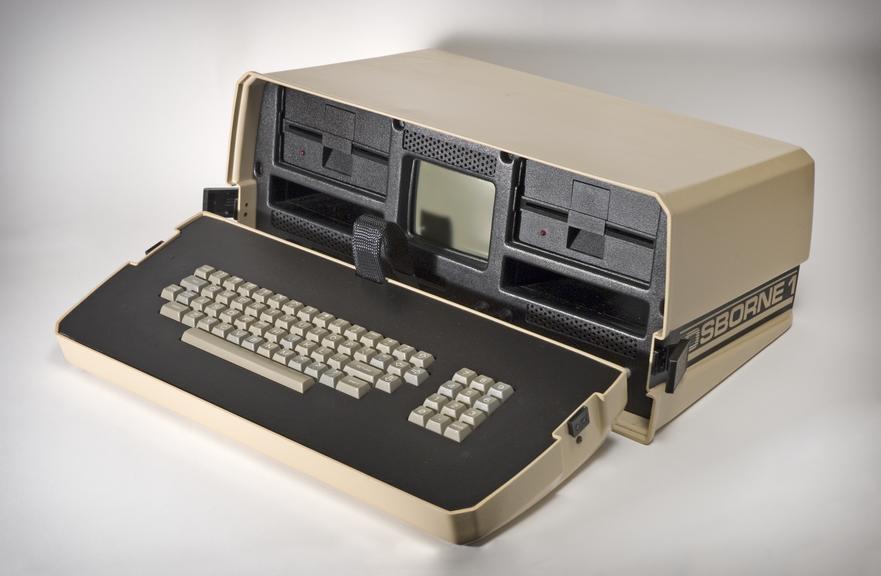
At Creative Computing, we got an Osborne O-1, the first portable computer in 1981, but the screen was too small for production work. I never got into the Commodore line: PET, C-64, Vic-20, or Amiga, nor the Atari 400, 800, or XE. We, of course, got an IBM PC in 1982, followed by several clones, and had largely switched over to them by 1984, shortly before Ziff-Davis shut down Creative Computing the following year.
When Betsy and I took over publishing Atari Explorer magazine in 1986, of course, we switched over to the Atari 1040. We found it to be a very nice capable machine which we happily used in the late 80s.
4. Have you ever met Chuck Peddle, the creator of the 6502 chip and the Commodore PET, or Steve Wozniak, the creator of the Apple II?
Yes, and also Bill Gates, Adam Osborne, Paul Allen, John Draper (Captain Crunch), Lee Felsenstein, Mitch Kapor, Ted Nelson (4th editor of Creative Computing), Alan Kay, Les Solomon, Nolan Bushnell, and so many other pioneers in the field.
Was it a great thrill to meet and get to know these people? To be perfectly honest, not really. Yes, they were people who had innovative ideas or engineering skills plus passion or persistence, or vision. But they were also generally likable, "ordinary" human beings you could go out with for a burger and beer. Interestingly, there were far more people who also had revolutionary ideas in this new field of personal computing that came to nothing (the idea or product, not the person).
The December 1983 issue of Creative Computing had more than 200 advertisers, many of which took full-page color ads, yet the majority of those products were abject failures in the long run.
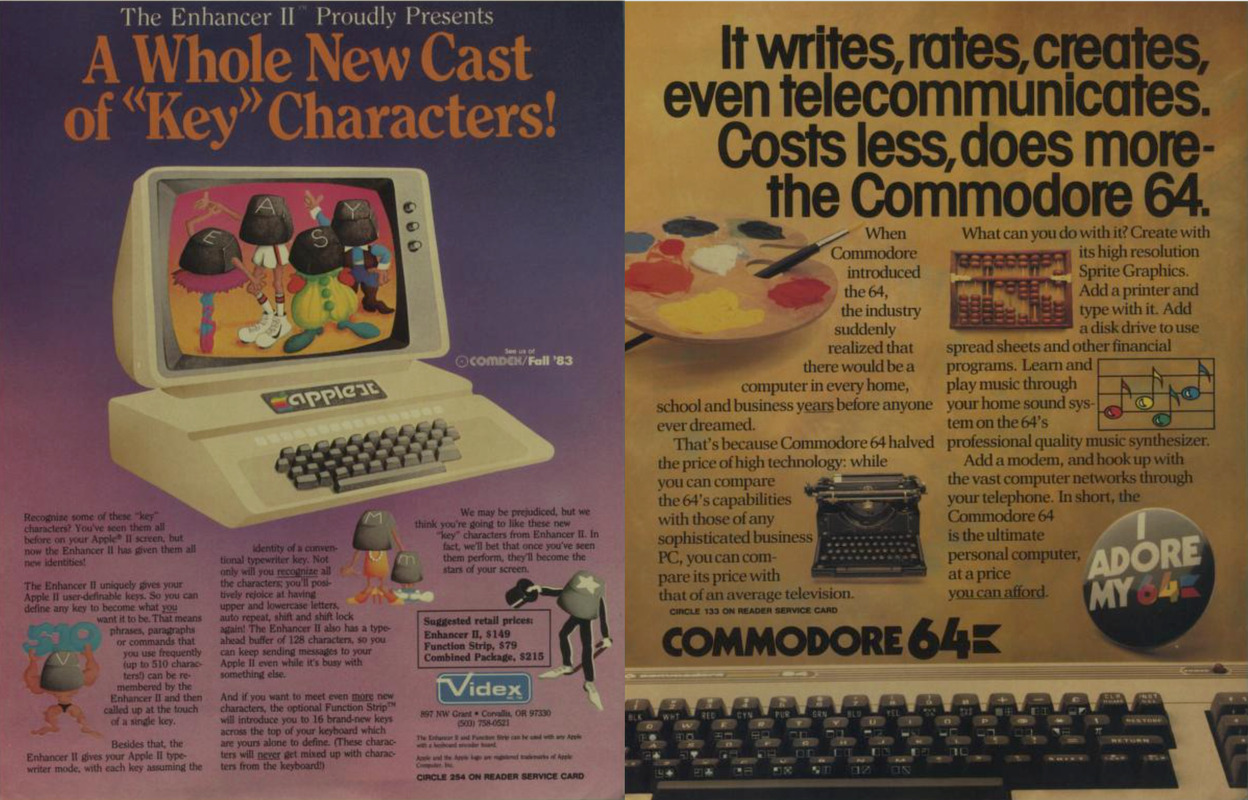
Of the 200 advertisers in that issue, I'd say fewer than 15 lasted more than three years.
5. You are recognized for the BASIC games published in your magazines and your books. Is BASIC the only programming language you used? If not, what other programming languages have you used?
I learned Burroughs machine code and Algol at Cornell Univ. in 1959. In my summer job at Grumman Aircraft, I learned Fortran. My graduate fellowship at Carnegie-Mellon Univ in 1961 was to translate the massive Management Game from GATE (on a Bendix G-20) to Fortran. In the Army, for a lark, I took a class to learn Cobol and wound up teaching the course. In my first job at Market Science Associates (1965-69), I was largely programming in Fortran and Control Data machine code.
At DEC, I wrote a lot of programs in Focal and also picked up Logo, Pascal, and Pilot. Oh, yes, BASIC too (no less than five versions). At Atari Explorer, I picked up a little bit of C and then more recently, HTML, XHTML, Perl, JavaScript, and CGI. So 15 languages in all.
6. Super Star Trek is probably the most famous of all the games published in your books and magazines. Was it your favorite game? If not, what was your favorite?
Star Trek was created by Mike Mayfield and originally published by Hewlett-Packard. Luckily, someone submitted it to DECUS (DEC user group), and I put it in 101 BASIC Computer Games as SPACWR published at DEC in 1973. Bob Leedom extended this DEC version dramatically and sent it to me just about the time I was leaving DEC. The company had no interest in it, so I hung on to it and published it in the Nov/Dec 1975 issue of Creative Computing as Super Star Trek. I took some heat from Paramount, who owned the rights to the name, but in 1977, I had a nice conversation with Gene Roddenberry and got his permission to use the Star Trek name.
At Creative Computing, Steve North and I converted the game to standard Microsoft BASIC which we continued to call Super Star Trek. This final version then appeared in January 1978 in the first edition of Basic Computer Games published by Creative Computing.
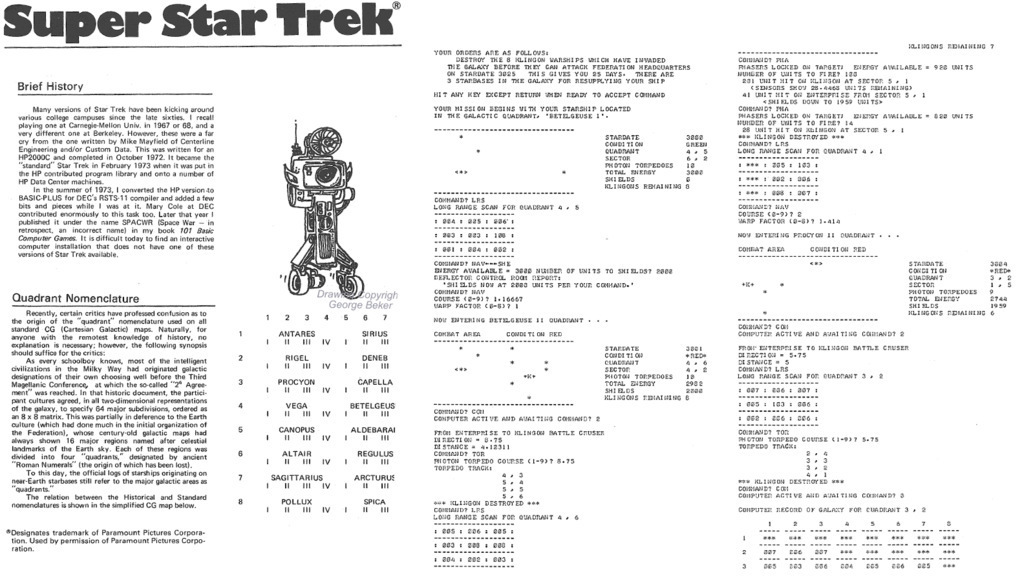
When you do so much programming on a game, you get to know it inside out, and frankly it's not so much fun to play. I rarely played the game largely because I was playing other games for a review in the magazine or trying to dream up new game concepts like the first laser videodisc game, Rollercoaster, that I wrote in 1979.
My all-time favorite game was Ladybug (a complex Pac-Man derivative) produced by Universal and released in 1981. We got a full-size arcade version at Creative Computing, and now, 40 years later, I still have it and play it from time to time.
7. In general, what is the best piece of software that you wrote?
The most-used program that I wrote was back in 1966 at Market Science Associates. It was a program to forecast the success (growth in sales and usage) of new consumer products. I submitted a description of it (but NOT the Fortran code) to the Journal of Market Research where it was published in April 1970. Ironically, many years later, when I was Manager of Marketing Communications at AT&T; (the Bell System), the AT&T; market research department came to me and said they had just licensed the use of the program from Market Science Associates and maybe I could help them with some of the input data. The program was originally designed to forecast the success of products like snacks, disposable diapers, a new flavor soft drink, etc., but AT&T; wanted to use it to predict the use of fax machines and possibly other communication services. As it turned out, it worked fine (I think).
The games that I wrote for Basic Computer Adventures (published by Microsoft Press in 1986) were by far my best programming efforts. The game, Hong Kong Hustle, for example, has the correct running schedule for all 34 public transportation lines in Hong Kong, Kowloon, and the New Territories: Star Ferry, MTR, tram, buses, and public sampan.
In the game, you, the Tai Pan, must use public transportation to recover as much of your gold and jewels stashed in different places throughout the colony before the Chinese take over the colony from the British on July 1, 1997. (I was there on that day.)
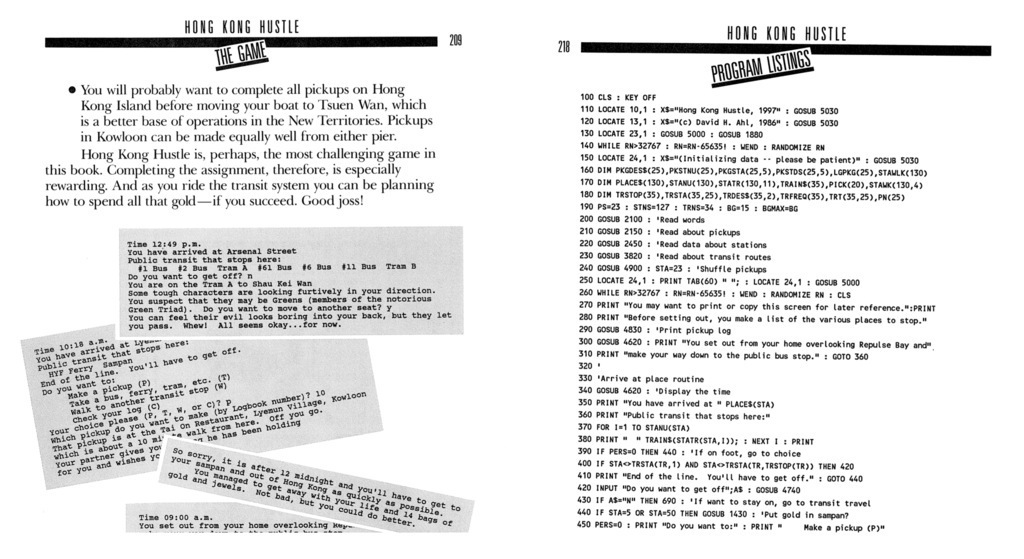
8. Retrogaming is now a trendy topic these days. Do you remember any particular game that you enjoyed a lot?
Back in the 80s, I enjoyed the adventure games by Scott Adams. But I never got into the games you play for days or weeks and go on seemingly forever. Even more so today, I like a simple game I can play in 5 or 10 minutes, have some fun and enjoyment, and then go back to work. I still enjoy Tetris on my Gameboy, Spider Solitaire, or Free Cell on my PC and trying to solve a Lewis Carroll or Bletchley Park puzzle from a book or magazine.
9. Are you still interested in technology and computers today?
Yes, I'm still interested in computers and technology. But loads of other things too: Bible research, automobile restoration, translating Quick & Flupke into English, photography, military history, baroque music, building small schools in Guatemala and Honduras, travel (I've visited 130 countries), investing (I manage four charitable trusts), book restoration, cats, patriotic covers from WWII, comic books (especially Iron Man, ROM, Wonder Woman, and Captain America), ancient Greek and Roman coins, NASCAR, cryptography, military vehicles, veterinary procedures, etc.
I generally read about 3 or 4 books a week, mostly action, adventure, espionage, mystery novels, but one "serious" subject for every 4 novels.
Don't ask me about smartphones. I don't have one. I'm not a Luddite, but at age 82, I just don't have a need for one.
10. You have been one of the first, if not the first, "technology educators". What suggestion do you have for teachers and educators that teach computer science today?
To be clear, I'm not a computer science teacher and never have been. I've written articles for The Mathematics Teacher, National Geographic World (for children), various Academic Press journals, the New York Times, as well as for loads of computer and technology publications. My underlying theme has always been: "the computer is a tool, no different from a pencil. Learn to use it. Learn how it can help you in whatever you're doing.
There are three aspects to education: memorization, thinking, and wisdom. The early years are for memorization: facts, multiplication tables, who, what, when. Then comes thinking (or knowledge): solving problems using those facts along with tools like a pencil, screwdriver, soldering gun, and a computer. Finally comes wisdom. Many people go through life without ever reaching this stage. Wisdom is figuring out which problems ought to be solved and which ones not. What things are knowable and should be attacked and what things are unknowable and in God's realm. Wisdom is ideas, judgement, vision, understanding, humility, and fear of the Lord. Strive for it.
Do you want to share anything else?
One last thing. When I retired from publishing in 2005, I continued developing and leading Bible studies, which I had started doing in the mid 90s. But I did one other important thing: I took a good portion of my savings and investments and established a charitable trust.
Five years later in 2010, two fellows that you might have heard of, Bill Gates and Warren Buffett, worth between them about $160 billion, started what they called "the Giving Pledge" in which billionaire signatories agreed to give away more than half of their wealth while they are still alive. The goal of making a public pledge was to encourage others to consider philanthropy, too, even if they weren't billionaires.
Okay, I'm obviously not a billionaire, not even close, but I definitely agreed with their goal, so I bumped up my charitable trust to include half of my wealth. It felt good. All right, I can't vaccinate 22 million children, but I can build a school in rural Honduras or Peru for 20 or 30 kids.
So, I felt like I was doing some good in the world. But then, a few years later God said to me, "hey Dave, let me introduce you to another guy who graduated from Cornell five years before you did. His name is Chuck Feeney, and he is a REAL champion of the pleasure of 'giving while living.' You know what, he's giving it ALL away!" And, by the way, so is David Green, founder of Hobby Lobby. What, everything! Are you kidding?
But the more I reflected, the more God's direction made sense. My kids are fine; they're earning a good living. Betsy and I are happy with our old house and our lifestyle. So why not give it all away? So I set up a new giving plan. It now has eight years to run, by which time I'll be 90. By then, all my money will be gone. Everything. Nothing left. And BOY does it feel good! WOW!
Thanks a lot, Mr. Ahl! It was a real honor to talk to you!
If you want to know more about David Ahl, you can check his website.



